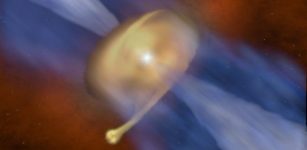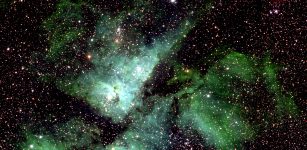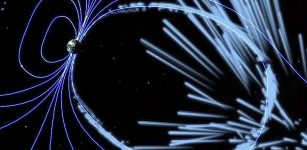Is Spacetime A Creation Of Well-Known Actors?
MessageToEagle.com – Questions about the nature of space and time have puzzled humanity since at least antiquity. Are space and time separated from matter, creating a “container” for motions and events occurring with the participation of particles, as Democrit proposed in the 5th century BC?
Or perhaps they are attributes of matter and could not exist without it, as Aristotle suggested a century later? Despite the passage of millennia, these issues have not been resolved yet. Moreover, both approaches, though contradictory, are deeply ingrained into the pillars of modern physics.
Artist concept of Gravity Probe B orbiting the Earth to measure space-time, a four-dimensional description of the universe including height, width, length, and time. Credit: NASA
Most physicists believe that the structure of spacetime is formed in an unknown way at the Planck scale, i.e., at a scale close to one trillionth of a trillionth of a meter. However, careful considerations undermine this prediction. There are quite a few arguments in favor of the emergence of spacetime as a result of processes taking place at the level of quarks and their conglomerates.
What is spacetime? The absolute, unchanging arena of events? Or perhaps it is a dynamic creation, emerging in some way on a certain scale of distance, time or energy. References to the absolute are not welcome in today’s physics. It is widely believed that spacetime is emergent. It is not clear, however, where the process of its emergence takes place. The majority of physicists tend to suppose that spacetime is created on the Planck scale, at distances close to one trillionth of a trillionth of a meter (~10-35 m).
In his article in Foundations of Science, Professor Piotr Zenczykowski from the Institute of Nuclear Physics of the Polish Academy of Sciences (IFJ PAN) in Cracow systematizes the observations of many authors on the formation of spacetime, and argues that the hypothesis about its formation at the scale of quarks and hadrons (or quark aggregates) is quite sensible for a number of reasons.
In quantum mechanics, events take place in a rigid arena with uniformly flowing time. Meanwhile, in the general theory of relativity, matter deforms elastic spacetime (stretching and twisting it), and spacetime tells particles how to move. In other words, in one theory, the actors enter an already prepared stage to play their roles, while in the other, they create the scenography during the performance, which in turn influences their behavior.
In 1899, German physicist Max Planck noticed that with certain combinations of some constants of nature, very fundamental units of measurement could be obtained. Only three constants—the speed of light c, the gravitational constant G and Planck’s constant h—were sufficient to create units of distance, time and mass, equal (respectively) to 1.62 · 10-35 m, 5.39 · 10-44 s and 2.18 · 10-5 g. According to today’s mainstream belief, spacetime would be created at Planck’s length. In fact, there are no substantive arguments for the rationality of this hypothesis.
Both our most sophisticated experiments and theoretical descriptions reach the scale of quarks, i.e., the level of 10-18 m. So how do we know that along the way to Planck’s length—over a dozen consecutive, ever smaller orders of magnitude—spacetime retains its structure? In fact, we are not even sure if the concept of spacetime is rational at the level of hadrons! Divisions cannot be carried out indefinitely, because at some stage the question of the next smaller part simply ceases to make sense. A perfect example here is temperature. This concept works very well on a macro scale, but when, after subsequent divisions of matter, we reach the scale of individual particles, it loses its raison d’etre.
“At present, we first seek to construct a quantized, discrete spacetime, and then ‘populate’ it with discrete matter. However, if spacetime were a product of quarks and hadrons, the dependence would be reversed—the discrete character of matter should then enforce the discreteness of spacetime,” says Prof. Zenczykowski.
See also:
Extra Dimensions In The Universe May Be Very Small – Scientists Say
Space-Time Warp May Exist Near Las Vegas – Could This Explain Why Time Slows Down In The Area?
“Planck was guided by mathematics. He wanted to create units from the fewest constants possible. But mathematics is one thing, and the relationship with the real world is another. For example, the value of Planck’s mass seems suspicious. One would expect it to have a value rather more characteristic for the world of quanta. In the meantime, it corresponds to approximately one-tenth of the mass of a flea, which is most certainly a classical object.”
Since we want to describe the physical world, we should lean toward physical rather than mathematical arguments. So when using Einstein’s equations, we describe the universe at large scales, and it becomes necessary to introduce an additional gravitational constant, known as the cosmological constant Lambda.
Therefore, while constructing fundamental units, if we expand the original set of three constants by Lambda, in the case of masses, we obtain not one but three fundamental values: 1.39 · 10-65 g, 2.14 · 1056 g, and 0.35 · 10-24 g. The first of these could be interpreted as a quantum of mass, the second is at the level of the mass of the observable universe, and the third is similar to the masses of hadrons (for example, the mass of a neutron is 1.67 · 10-24 g). Similarly, after taking Lambda into account, a unit of distance of 6.37 · 10-15 m appears, very close to the size of hadrons.
Just as the interactions between sand grains form a smooth surface on the beach, the spacetime known to us could be the result of relations between quarks and their conglomerates. Credit: IFJ PAN
“Playing games with constants, however, can be risky, because a lot depends on which constants we choose. For example, if spacetime was indeed a product of quarks and hadrons, then its properties, including the velocity of light, should also be emergent. This means that the velocity of light should not be among the basic constants,” says Prof. Zenczykowski.
Another factor in favour of the formation of spacetime at the scale of quarks and hadrons are the properties of the elementary particles themselves. For example, the Standard Model does not explain why there are three generations of particles, where their masses come from, or why there are so-called internal quantum numbers, which include isospin, hypercharge and colour.
In the picture presented by Prof. Zenczykowski, these values can be linked to a certain six-dimensional space created by the positions of particles and their momenta. The space thus constructed assigns the same importance to the positions of particles (matter) and their movements (processes). It turns out that the properties of masses or internal quantum numbers can then be a consequence of the algebraic properties of 6-D space. What’s more, these properties would also explain the inability to observe free quarks.
“The emergence of spacetime may be associated with changes in the organization of matter occurring at a scale of quarks and hadrons in the more primary, six-dimensional phase space. However, it is not very clear what to do next with this picture. Each subsequent step would require going beyond what we know. And we do not even know the rules of the game that nature is playing with us—we still have to guess them.
However, it seems very reasonable that all constructions begin with matter, because it is something physical and experimentally available. In this approach, spacetime would only be our idealization of relations among elements of matter,” says Prof. Zenczykowski.
MessageToEagle.com












